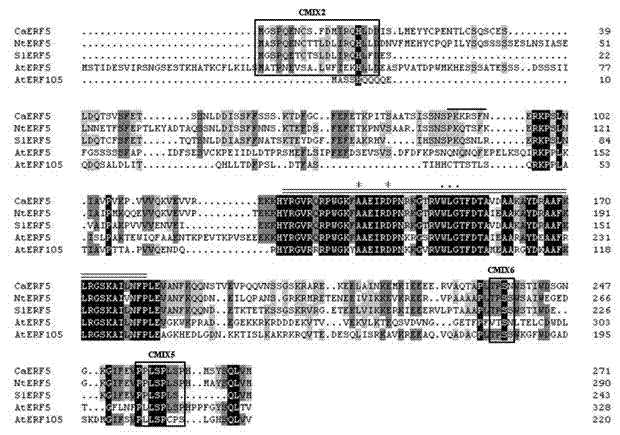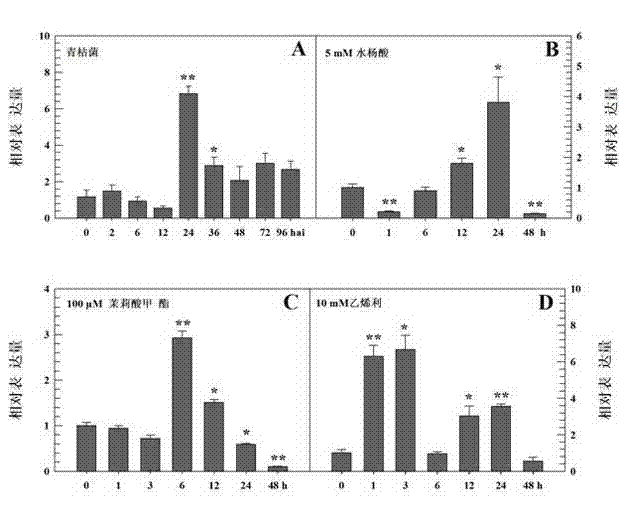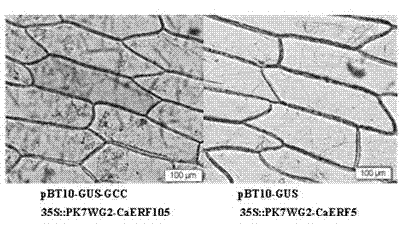Hot pepper adipocyte protein 2 (AP2)/ethylene responsive factor (ERF) transcription factor gene and application thereof
A transcription factor and gene technology, applied to pepper AP2/ERF transcription factor gene and its application field, can solve problems such as limited research, achieve important application value and improve the effect of bacterial wilt resistance
- Summary
- Abstract
- Description
- Claims
- Application Information
AI Technical Summary
Problems solved by technology
Method used
Image
Examples
Embodiment 1
[0031] Embodiment 1, CaERF105 Isolation of full-length cDNA
[0032] Using the amino acid of Arabidopsis ERF104 (At5g61600) as a probe, the pepper EST sequence was obtained from GenBank (www.ncbi.nlm.gov / ), and the contig analysis was performed by DNAMAN to obtain the conserved domain of ERF protein. For the consensus sequence, specific primers were designed according to the consensus sequence using PRIMER5 software. Detected in pepper homogenized cDNA library treated with 5 mM SA (library construction is based on equal amount of total RNA of pepper plants treated with SA for 0 h, 1 h, 3 h, 6 h, 12 h, 24 h, 48 h as the initial material) Primers to the band of interest are as follows:
[0033] forward -F: 5'-CAACGAACGCAAGCCATCT -3',
[0034] reverse -R:5'-GCCTTAGCCGCATCCAC-3'.
[0035] The number of amplification cycles was 35, and the PCR reaction conditions were pre-denaturation at 94°C for 5 min, denaturation at 94°C for 30 s, annealing at 52°C for 30 s, extension at 72...
Embodiment 2
[0041] Embodiment 2, CaERF105 Expression pattern analysis
[0042] The experimental materials were pepper plants with the same growth period for 25 days. The leaves were sprayed with 5 mM salicylic acid (SA) and 0.1 mM methyl-jasmonic acid (MeJA) dissolved in 10% ethanol, respectively, ( The corresponding control is 10% ethanol solution). The leaves were sprayed with 10 mM Ethephon dissolved in water, and the corresponding control was water. Take eight-week-old pepper plants and divide them by 10 8 cfu / mL R. solanacearum for root irrigation. Leaves of treated plants and corresponding control plants were collected at different times (0-48 / 96 h), and immediately snap-frozen in liquid nitrogen and placed at -70°C for subsequent analysis.
[0043] Select high-quality equivalent RNA and refer to PrimerScript from TaKaRa Company TM RT reagent Kit for reverse transcription. 1 μL of the reverse-transcribed single-stranded cDNA diluted 10-fold was used as a template. capsicum ...
Embodiment 3
[0045] Example 3, Transient expression analysis of CaERF105, GCC-box and CRT / DRE cis-acting elements
[0046] The present invention adopts BiolisticPDS-1000 / He (BioRad) gene gun to carry out gene gun bombardment method to carry out instantaneous expression analysis. The onion epidermis (1 cm × 1 cm) was torn off and cultured on solid MS (2% agar, 3% sucrose, pH 5.8), and cultured at 25°C in the dark for 1 day. 10 μg of the PK7WG2 plasmid containing the target gene and 10 μg of the pBT10-GUS-2GCC plasmid bombarded the onion epidermis at the same time, spread it on MS and cultured it in the dark for 18 hours, then observed it under the X-Gluc staining microscope and took pictures. Such as image 3 As shown, after X-Gluc staining, the expression of GUS gene can be detected in the onion epidermis co-transformed with CaERF105 and pBT10-GUS-2GCC, but the expression of GUS gene cannot be detected in the onion epidermis co-transformed with pBT10-GUS, indicating that CaERF105 Can be ...
PUM
 Login to View More
Login to View More Abstract
Description
Claims
Application Information
 Login to View More
Login to View More - R&D
- Intellectual Property
- Life Sciences
- Materials
- Tech Scout
- Unparalleled Data Quality
- Higher Quality Content
- 60% Fewer Hallucinations
Browse by: Latest US Patents, China's latest patents, Technical Efficacy Thesaurus, Application Domain, Technology Topic, Popular Technical Reports.
© 2025 PatSnap. All rights reserved.Legal|Privacy policy|Modern Slavery Act Transparency Statement|Sitemap|About US| Contact US: help@patsnap.com



